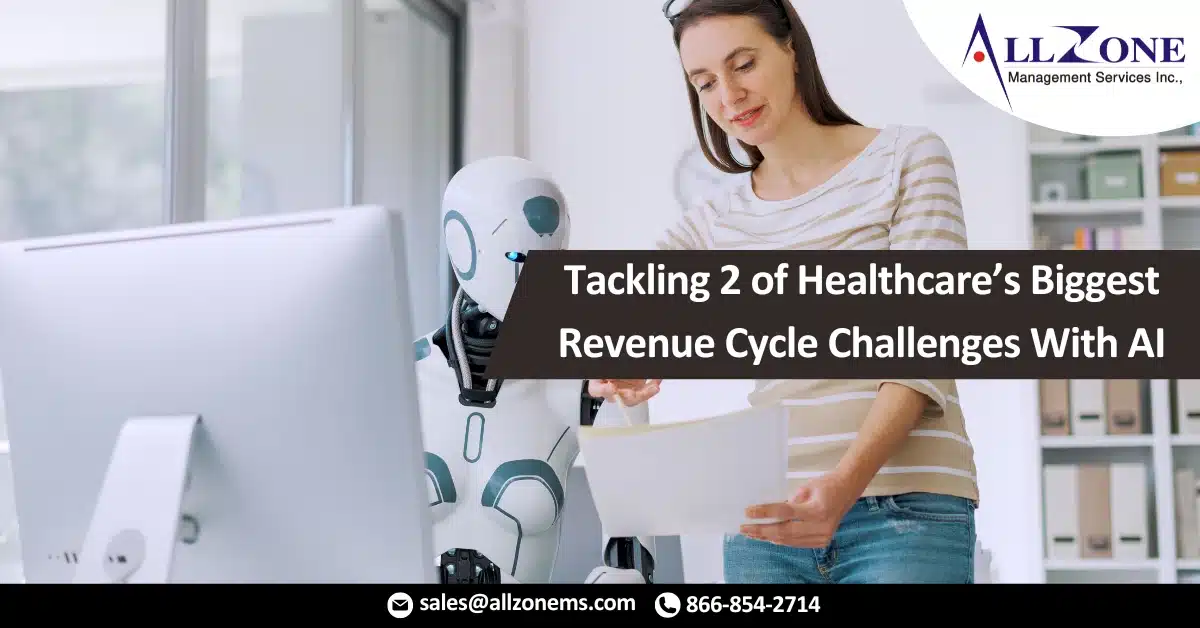Data was big in revenue cycle challenges long before “Big Data” was a buzzword. The same goes for the challenges that come with it.
For years, revenue cycle challenges for leaders have looked for answers to common hurdles like missing or incorrect charges, payment file problems, and data transfer timing delays. Big Data and advanced analytics in the form of artificial intelligence in RCM are regularly tossed around as potential solutions. When you look at the possibilities AI holds for revenue cycle, the opportunities seem endless — and that’s part of the problem.
Big Data is so big and AI is so expansive, it can be challenging to understand where exactly to focus your limited resources to ensure you’re not only getting the most out of your investment, but that you’re also optimizing your application of a powerful tech solution.
Understanding AI For The Hospital Revenue Cycle
The future of revenue cycle challenges is full of exciting opportunities, especially when you look at things through an AI-enabled lens.
Yes, AI is a tech solution, but at its core, it offers the ability to do more with the wealth of patient, vendor, and payer information you already have. Revenue cycle leaders are sitting on treasure troves of data that, when approached from the right angle, can clarify paths to lower costs, additional profit, and an improved patient experience.
Today’s shifting reimbursement environment is one where patients are taking on more of the financial burden, but at the same time, are losing confidence in their ability to handle their growing responsibility. A recent survey from the Commonwealth Fund found that only 62.4 percent of adults felt somewhat or very confident they could afford their own healthcare, a drop from 70 percent in 2015. The problem doesn’t stop at patient wallets. A survey by Care Payment found 44 percent of patients would neglect seeking care if their out-of-pocket costs reached $500, even if this decision put their health at risk.
This is a complex challenge with real implications for patients and providers alike, and one that requires sophisticated insight. AI is perfectly positioned to address two fundamental revenue cycle challenges in particular: revenue cycle challenges in leakage and the patient financial experience.
Addressing The Leakage Issue
A typical hospital can expect to lose between one and five percent of net revenue because of leakage from reimbursement issues. This average doesn’t reflect the increasing impact of ICD-10 (and just around the corner, 11), the unpredictable evolution of the ACA, ongoing payer reimbursement changes, and ballooning patient out-of-pocket costs. That looming wave of complexity is an ideal challenge for AI and machine learning solutions.
For example, an AI solution can take data from procedures, diagnostics, and billing and charge codes and compile them into a database from which it extracts insights that would be hidden from humans and even lower-tech solutions. An advanced analytic solution can take the same database, compare present and past cases, and identify variances. After an auditor steps in to provide feedback on machine-based recommendations, the system will learn and improve on its own, even as the revenue cycle environment continues to evolve. Effective solutions will even track auditors to help advance hospital front-end processes and facilitate end-to-end improvement.
Advancing The Patient Financial Experience
In the past, changes in the revenue cycle environment were burdens shouldered primarily by hospitals. Today, though, patients are picking up an increasing share of the revenue cycle relationship, and in some ways, they’re actually ahead of the game.
The concept of the patient financial experience is rooted in the idea of patients as consumers — one that’s heavily shaped by other industries, including retail, finance, and hospitality. While these expectations might seem like increased demands on revenue cycle leadership, they’re actually powerful insights into the type of relationship that needs to exist to help patients help provider organizations navigate modern revenue cycle challenges.
AI solutions open the door to future-oriented initiatives like scoring at every patient touch point, designing consumer-friendly, intelligent revenue cycle communications, and the ability to measure critical metrics and adjust on the fly.
Most hospitals have untapped opportunity to do these things and more with a straightforward, data-focused approach to patient communications. Your patient conversations are the lifeblood of your relationships. Using AI to kick off data-based, personalized conversations to directly influence payment behavior and encourage patient engagement is a powerful start to building revenue cycle processes that are adapted to the future of healthcare consumer engagement.
AI also allows you to access predictive modeling and understand probable patient outcomes, so your future communications won’t just be shots in the dark — they’ll be informed, patient-centered outreach that respectfully pulls your patients in and helps them meet their desires of maintaining a positive financial relationship with you.
If there’s one thing revenue cycle leadership should remember about AI, it’s that it isn’t simply a tool. It can be a powerful ally that grows with your organization and the revenue cycle landscape just as you need it most.
For More Information: https://www.healthitoutcomes.com/doc/tackling-of-healthcare-s-biggest-revenue-cycle-challenges-with-ai-0001

